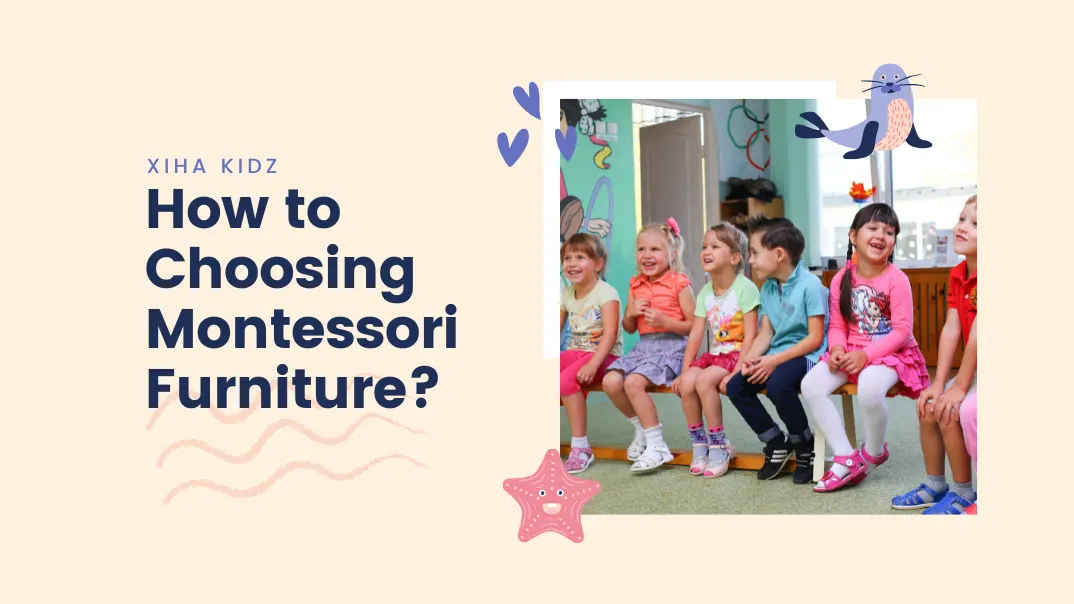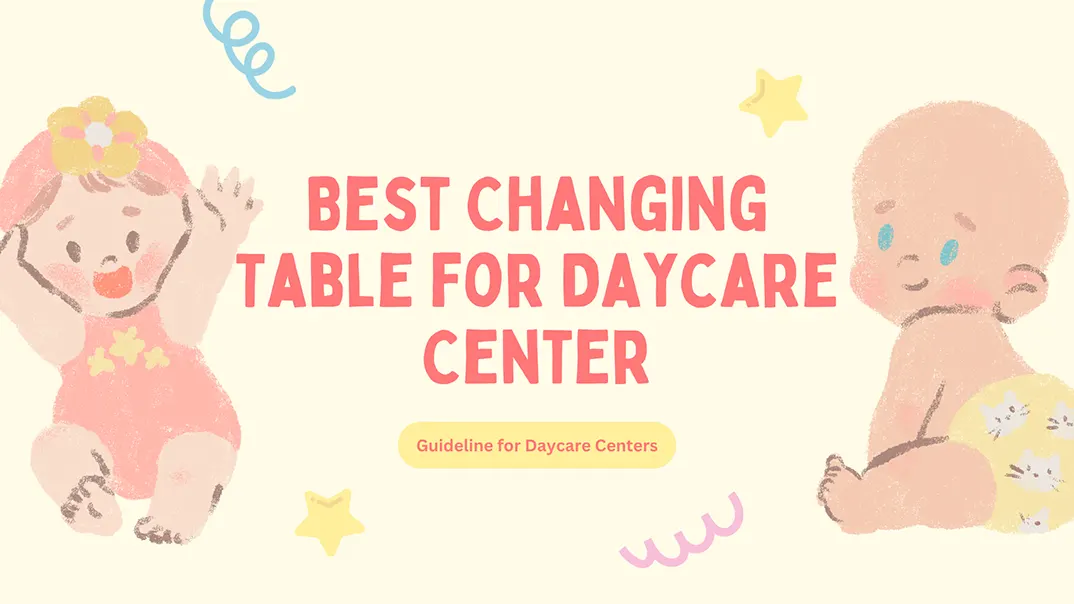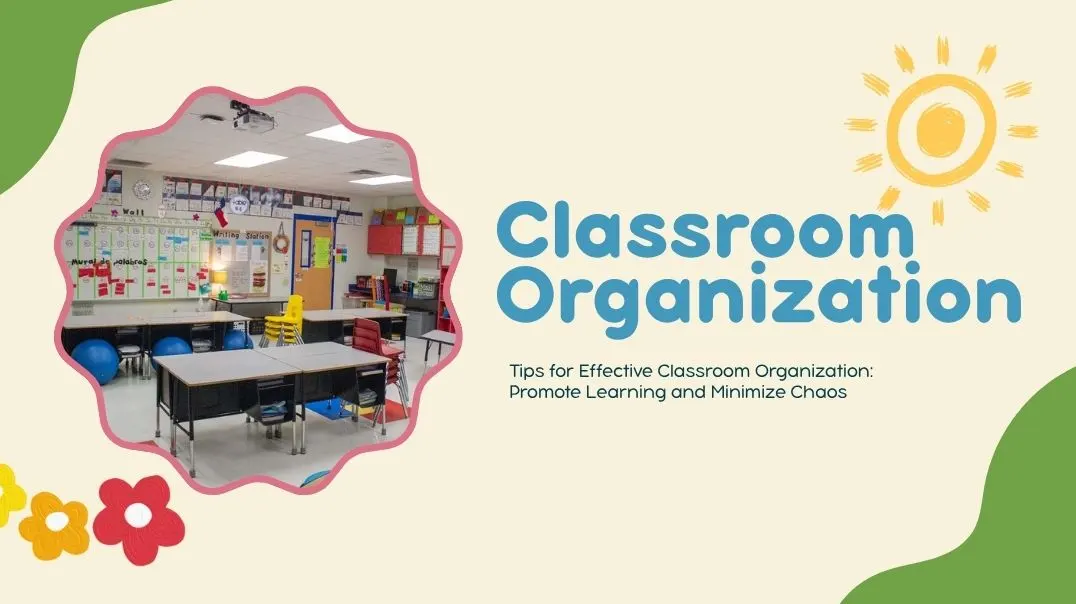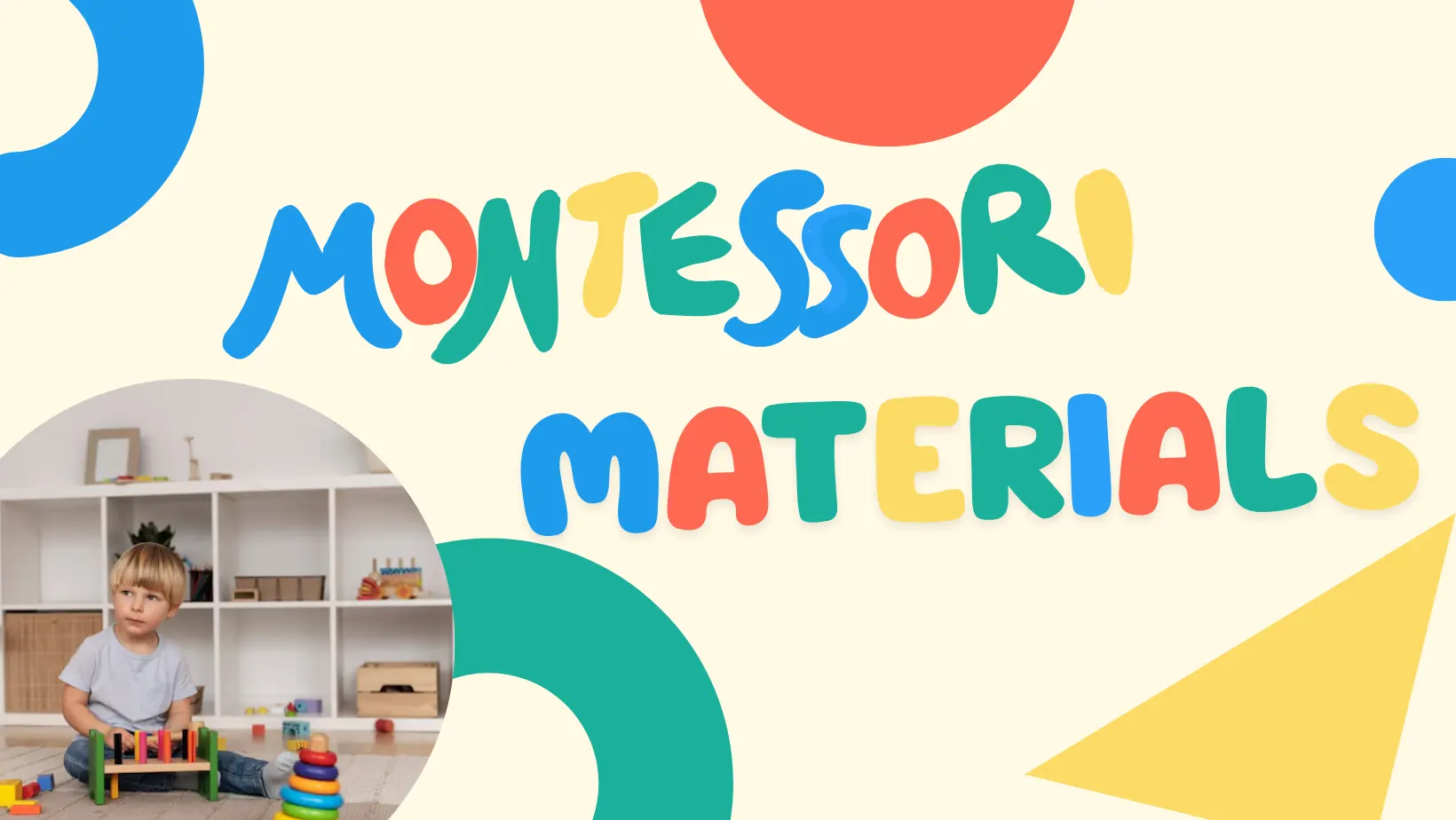Are you struggling to choosing Montessori furniture for your classroom or home? Montessori furniture is essential to creating an environment that fosters independence, creativity and self-motivation in children. Whereas standard furniture does not conform to Montessori principles, using it can hinder a child’s natural growth and learning.
So, let’s learn how to choose Montessori furniture to make an informed choice for your home or classroom.
What is Montessori Furniture?
Montessori furniture is a unique category of child-centric furniture designed to foster independence and developmental growth. It is tailored to be accessible, functional, and appealing, allowing children to interact with their environment freely and safely.
Montessori furniture aligns with the educational philosophy pioneered by Dr. Maria Montessori, emphasizing hands-on learning, self-reliance, and respect for a child’s natural developmental process. Every piece is purposefully designed to empower children, from child-sized tables to low shelves.
Parents and educators love Montessori furniture for helping children learn life skills, cultivating responsibility, and nurturing a love for exploration.
Understanding the Montessori Method

The Montessori method is an educational philosophy that emphasizes independence, freedom within limits, and respect for a child’s natural psychological development. It revolutionized the way we view childhood learning environments.
The Montessori approach’s core lies in the belief that children are naturally curious and capable learners. By designing furniture and spaces that cater to their needs, children are empowered to explore and engage.
Imagine a room where everything is accessible to the child, from a chair they can lift to a shelf that doesn’t require adult help. This environment fosters confidence and autonomy. It’s not about providing more but about providing the right tools. Montessori furniture plays a pivotal role in bringing this philosophy to life.
Things to Pay Attention to When Choosing Montessori Furniture
When selecting Montessori furniture, it’s crucial to focus on features that align with the Montessori philosophy and meet the practical needs of your child.

1. Child-Centered Design
Montessori furniture should be appropriately scaled to your child’s size. A chair they can lift or a shelf they can reach independently fosters autonomy and confidence. This child-friendly design empowers children to engage with their surroundings without needing constant adult assistance.
2. Safety Features
Children are naturally curious and active. Ensure your chosen furniture has rounded edges, sturdy construction, and non-toxic finishes. A wobbling chair or sharp-edged table can become a hazard, undermining the safe learning environment you aim to create.
3. Durability and Quality
Investing in high-quality furniture pays off in the long term. Montessori furniture often becomes a staple of your child’s daily routine, so it must withstand wear and tear. Opt for pieces crafted from solid wood or high-quality materials known for longevity.
Transform Your Classroom with Custom Furniture Solutions
4. Aesthetics and Functionality
Montessori furniture tends to be minimalist, with natural materials and muted colors that help create a calming environment. This simplicity encourages focus and reduces distractions, key to fostering a child’s concentration and engagement.
5. Adaptability and Longevity
Children grow quickly, and their needs evolve. Adjustable furniture like height-adaptable tables and chairs allows for long-term use and cost efficiency.
Types of Montessori Furniture
Montessori furniture has various designs to support a child’s growth and development. Here is a detailed look at each type:
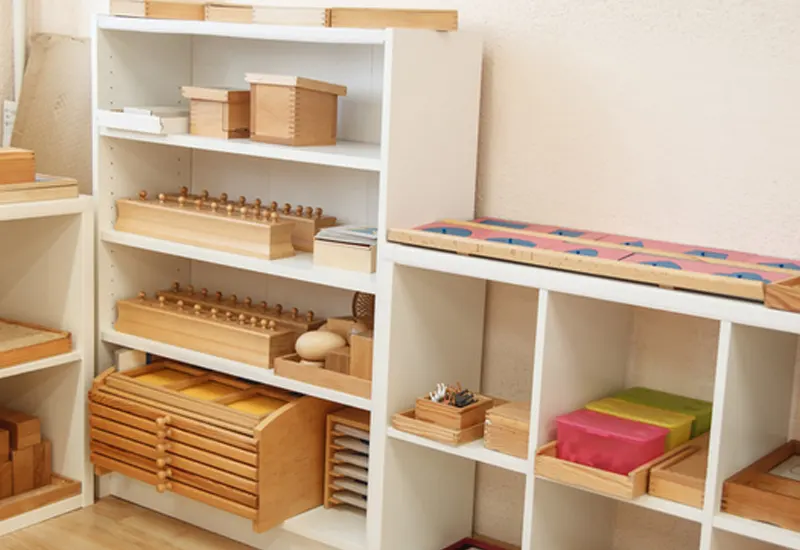
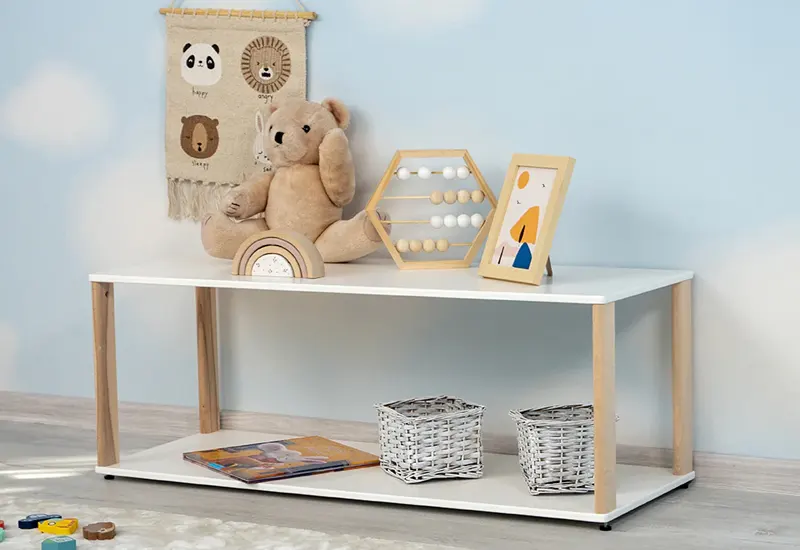

Shelving Units
- Low, open shelves: Designed for easy access, allowing children to select and return materials independently.
- Movable shelves: Ideal for rotating toys and activities, keeping the space engaging without being overwhelming.
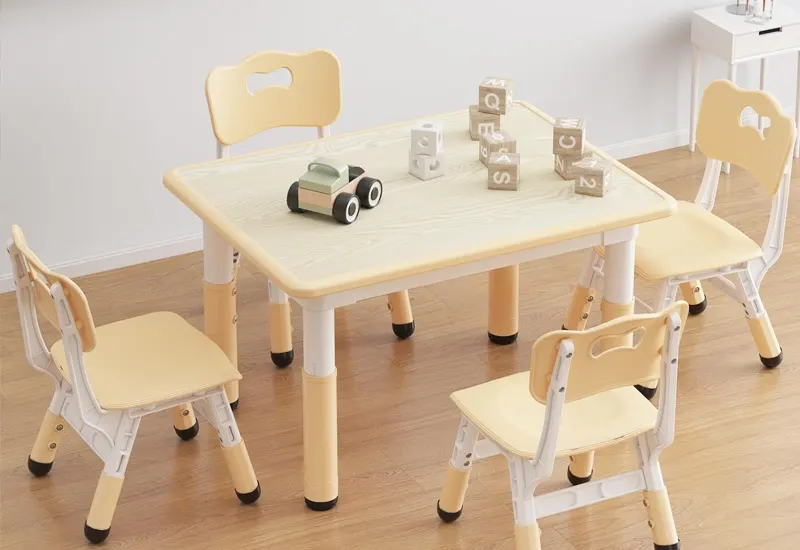
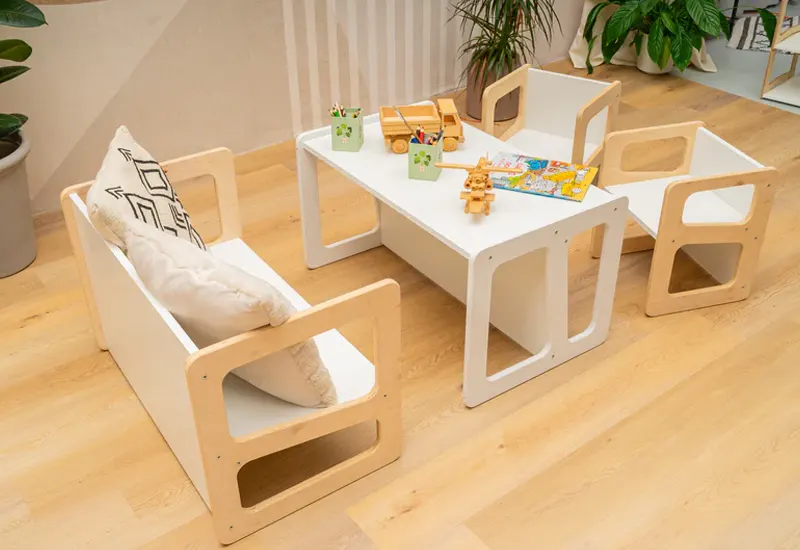

Tables and Chairs
- Child-sized furniture: Encourages proper posture and makes it easier for children to participate in activities.
- Adjustable options: Accommodate growth, making them a cost-effective choice for parents and schools.
Beds

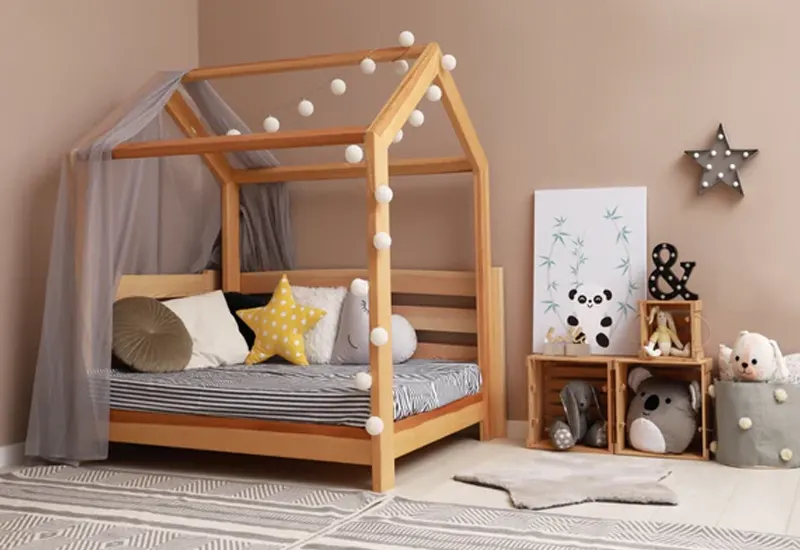
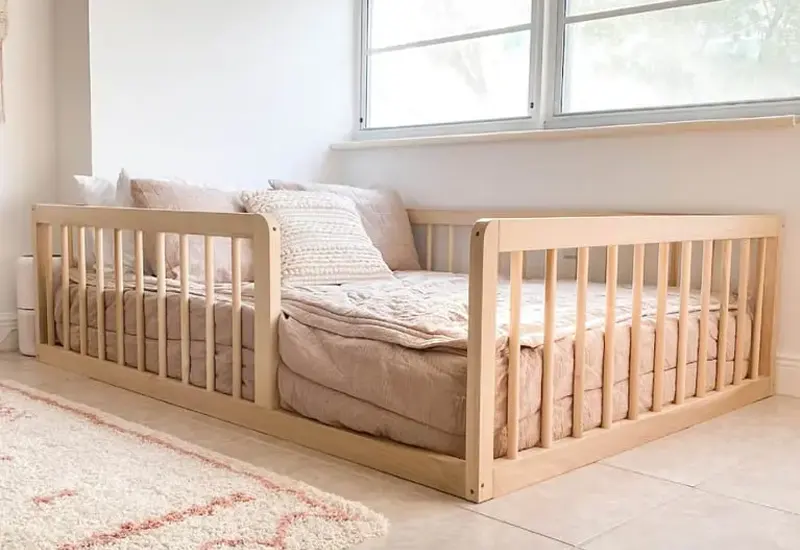
- Montessori floor beds: Positioned close to the ground, empowering children to manage their sleep routines independently.
Practical Life Stations
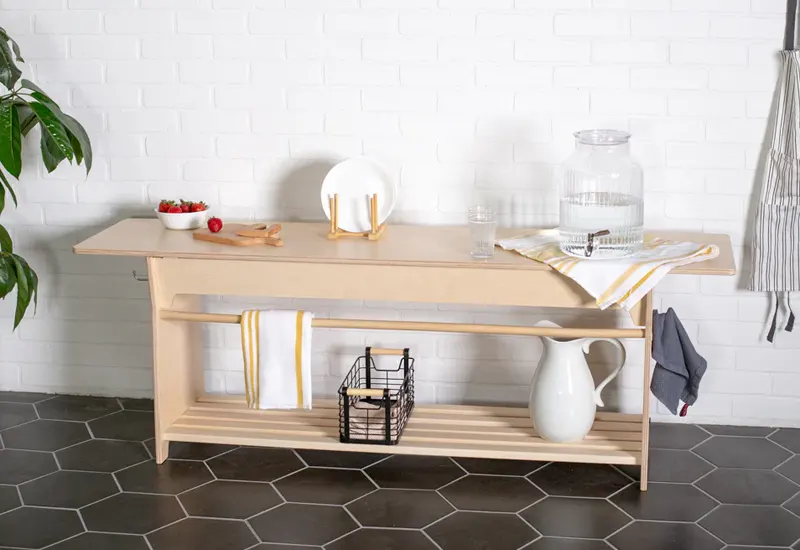
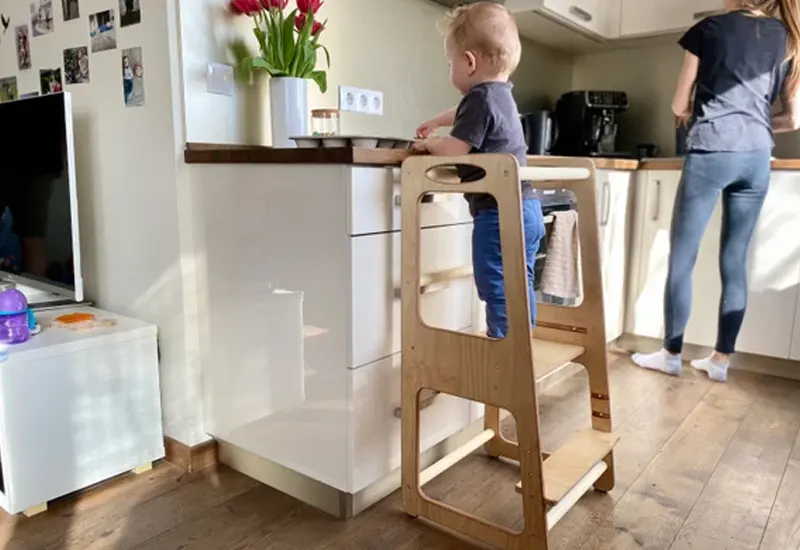

- Learning towers: Provide a safe platform for children to engage in activities like cooking or washing dishes.
- Step stools: Help children reach sinks, counters, or shelves without adult assistance.
Wardrobes and Dressers

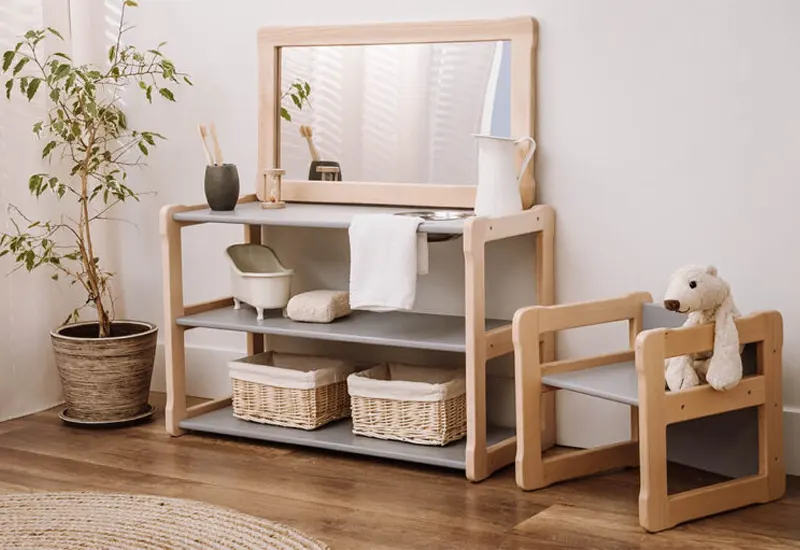

- Child-sized closets: Enable children to choose their outfits, promoting decision-making and responsibility.
- Open drawers or racks: Make clothing organization simple and intuitive.
Play Furniture

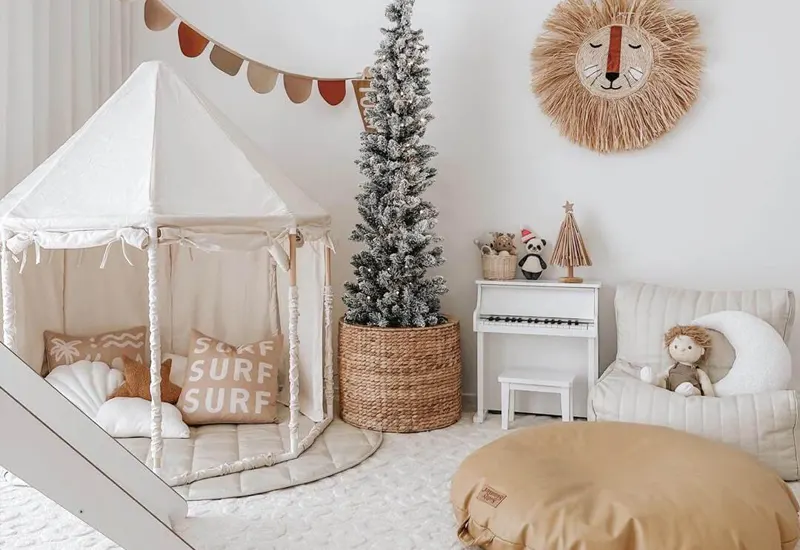
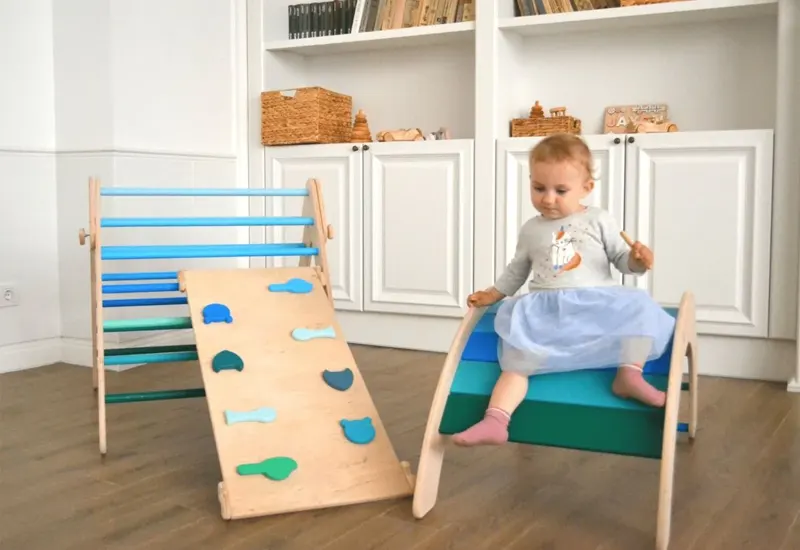
- Tents and forts: Foster imaginative play in a cozy, child-friendly setting.
- Small sofas or chairs: Offer spaces for relaxation and quiet time.
Each type of furniture serves a unique purpose in supporting the Montessori principles of independence, creativity, and collaboration.
Materials Used in Montessori Furniture
The materials used in Montessori furniture are carefully chosen to ensure safety, durability, and alignment with the Montessori philosophy.
1. Natural Wood
Wood is the gold standard for Montessori furniture. It is:
- Durable and long-lasting: Ideal for active children.
- Eco-friendly: Often sourced sustainably, supporting environmental values.
- Warm and inviting: This creates a natural connection that enhances sensory exploration.
2. Non-Toxic Finishes
Since children often touch and taste their surroundings, choosing furniture with non-toxic finishes like water-based paints or natural oils is crucial. These finishes ensure safety without compromising durability.
Transform Your Classroom with Custom Furniture Solutions
3. Fabrics for Cushions and Mats
For upholstered furniture or floor seating, look for hypoallergenic and washable fabrics. Organic cotton or linen is a great choice for ensuring comfort and safety.
4. Sustainable Plastics (Optional)
While less common, some Montessori furniture incorporates eco-friendly plastics, particularly for outdoor settings or lightweight options. Ensure these materials are BPA-free and environmentally responsible.
Importance of Montessori Furniture
Montessori furniture doesn’t just serve functional needs—it plays a transformative role in a child’s overall development.

Foster Independence
Montessori furniture is designed to empower children. Providing child-sized items allows them to sit, stand, and reach without adult assistance. This sense of control over their environment boosts confidence.
Improve Learning
A well-designed Montessori space supports concentration and curiosity. For example, a low table invites a child to work on puzzles or crafts, enhancing problem-solving skills.
Cognitive Development
Furniture that encourages hands-on activities helps develop critical thinking and fine motor skills. Practical life furniture, like dressing frames, directly contributes to cognitive growth.
Order and Discipline
Montessori furniture teaches children to organize and respect their surroundings. Open shelves encourage children to return items to their proper place, promoting discipline and responsibility.
Sensory Exploration
Natural materials like wood engage a child’s senses, offering tactile and visual experiences. This exposure aids sensory development and helps children connect with the natural world.

Main Principles of Montessori Furniture
Montessori furniture is rooted in a few core principles that align with the Montessori philosophy of fostering independence, creativity, and natural learning.
Child-Size
One of the most defining features of Montessori furniture is that it’s designed to fit the child, not the adult.
- Reason: Children feel more confident and capable when independently accessing and using their furniture.
- Examples: Chairs with low seats, tables with appropriate heights, and shelves reachable by little hands.
- Practical Tip: Always measure your child’s height and proportions before buying furniture. For instance, their feet should rest flat on the ground when sitting.
Accessibility
Accessibility is at the heart of Montessori design. Every piece of furniture is meant to empower the child to explore and organize their space.
- Reason: When children can easily access toys, books, or clothes, they gain independence and learn responsibility.
- Examples: Open shelves for toys, low hooks for coats, and trays for art supplies.
- Practical Tip: Avoid clutter by limiting the number of items on display. Rotate toys and books to maintain interest and focus.
Transform Your Classroom with Custom Furniture Solutions
Natural Materials
Montessori furniture prioritizes materials like wood, which are durable, warm, and eco-friendly.
- Reason: Natural materials create a calming environment and engage children’s senses.
- Examples: Solid wood tables, organic cotton cushions, or wool rugs.
- Practical Tip: Ensure all finishes are non-toxic and child-safe to keep the environment healthy.
Simple and Orderly
A Montessori environment should inspire focus and concentration through simplicity and order.
- Reason: Overly complex designs can overstimulate children and reduce their ability to focus.
- Examples: Clean-lined furniture without intricate patterns or excessive colors.
- Practical Tip: Keep the space minimalistic by organizing items into designated zones, such as a reading corner or a craft table.
Open Play
Furniture should encourage open-ended activities that spark creativity and exploration.
- Reason: Open play supports cognitive and emotional development.
- Examples: Movable furniture pieces, play tables, or soft floor mats for building blocks.
- Practical Tip: Choose versatile furniture like low benches or storage units that can double as play surfaces.
Choosing Montessori Furniture to Layout Space
Designing a Montessori-inspired home requires a balance of functionality, accessibility, and aesthetics. Each room should serve the child’s needs, fostering independence, exploration, and learning. Below is a detailed guide to how each room can be thoughtfully arranged using Montessori principles.
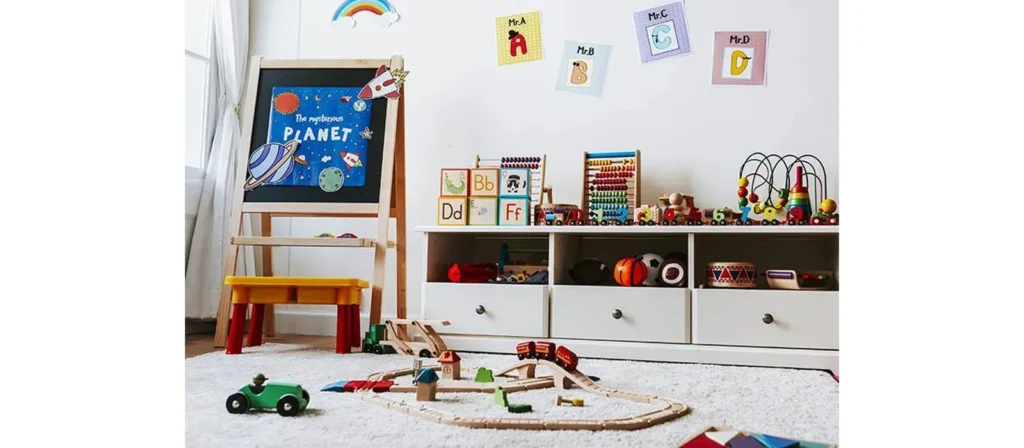
Living Room
The living room can become a multi-functional space where children can play, relax, and engage in learning activities while feeling part of the family environment.
- Designate a play area: Set up a cozy corner with a soft rug and a low shelf for toys and books. Include items like puzzles, stacking blocks, and sensory toys. Rotate these materials regularly to maintain engagement.
- Incorporate child-sized furniture: Add a small chair and table for drawing, coloring, or reading. Ensure it blends well with the room’s decor to maintain a cohesive look.
- Create a quiet zone: Place a bean bag or a floor cushion by a bookshelf to encourage reading and quiet play.
- Low decorations and artwork: Hang family photos or child-friendly artwork at the child’s eye level to personalize the space and make it inviting.
- Natural elements: Add potted plants in child-safe planters. Teach your child to care for them as a life skill.
Keep the room organized with baskets or fabric bins for quick cleanup, ensuring the space is always ready for exploration.

Bedroom
A Montessori bedroom should promote independence and create a sense of ownership for the child. It is a personal space where they can rest, play, and learn to care for their belongings.
- Floor bed: Replace a traditional crib or high bed with a low, floor-level mattress. This setup allows toddlers to get in and out independently, fostering autonomy.
- Accessible wardrobe: Install a low-hanging rod or use a small dresser to let the child choose their clothes. Open baskets or cubbies can help organize socks, shoes, and accessories.
- Toy and book storage: Use low shelves or boxes for easy access. Arrange toys and books neatly to encourage the child to return items to their designated spots.
- Decorations and lighting: Use warm lighting and calming colors like soft blues or greens. Decorate with simple, natural themes, such as animal or botanical prints.
Keep distractions minimal—limit the number of toys in the bedroom to make it a space primarily for rest and quiet play.

Playroom
A dedicated playroom in a Montessori home is where creativity and exploration take center stage. It should inspire imaginative play and hands-on learning.
- Define activity zones: Separate the room into areas for different types of play. For example:
- A building zone with blocks and construction toys.
- A pretend-play zone with costumes or a small play kitchen.
- An art zone with a small easel, paints, and paper.
- Open shelving: Use low, open shelves to display toys and materials neatly. Organize by category, such as puzzles, books, or musical instruments, to make choices easy.
- Floor space: Leave a large open area in the center of the room for movement-based activities like yoga, dance, or tumbling. Add a soft mat for safety.
- Child-accessible storage: Include labeled bins or baskets for organizing smaller items like craft supplies or figurines.
- Interactive wall elements: Install a low-height chalkboard, corkboard, or sensory board for hands-on activities.
Include multi-functional furniture, such as a table with storage underneath, to maximize space while keeping the room tidy.

Kitchen
The kitchen is a prime space for teaching practical life skills, such as food preparation and cleanup. A Montessori-inspired kitchen setup encourages children to participate in daily routines.
- Learning tower: Place a sturdy learning tower by the counter to help the child safely reach surfaces for cooking or baking activities.
- Child’s kitchen station: Set up a small table with a chopping board, utensils, and a pitcher for pouring water. This allows the child to prepare simple snacks.
- Accessible storage: Designate a low cabinet or drawer for the child’s plates, cups, and utensils.
- Snack area: Create a mini snack station with healthy options like fruit, crackers, or pre-cut veggies. Use small, clear containers to make choices easy.
- Cleaning supplies: Provide a child-sized broom, mop, and cloth to teach responsibility for cleaning up spills.
Involve your child in setting the table or washing dishes. These activities build fine motor skills and instill a sense of contribution.
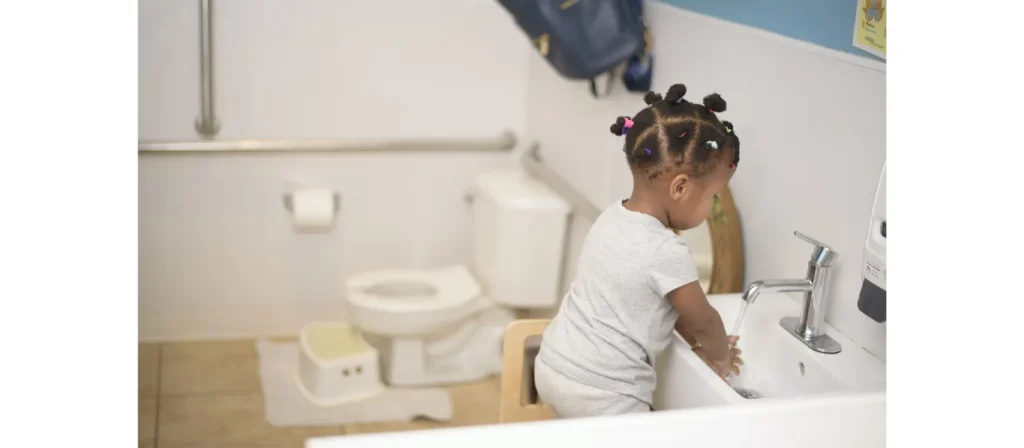
Bathroom
A Montessori bathroom setup helps children develop independence in personal hygiene and self-care tasks.
- Step stool: Place a sturdy step stool by the sink so the child can wash their hands and brush their teeth independently.
- Low hooks or racks: Install hooks for towels or bathrobes at the child’s height.
- Organized toiletries: Use small containers or caddies for essentials like toothbrushes, toothpaste, and soap. Label them to teach organization.
- Potty training aids: Add a child-sized toilet seat or potty chair to make toilet use easy and stress-free.
- Mirror at eye level: Hang a shatterproof mirror at the child’s height to help with grooming activities like brushing hair.
Keep the bathroom safe by storing cleaning products and sharp objects out of reach. Choose slip-resistant mats for added safety.

Classroom
The classroom should be organized, functional, and inspiring if you’re homeschooling or creating a Montessori learning space at home.
- Workstations: Use child-sized desks or tables grouped by activity type, such as art, reading, or science exploration. Adjustable furniture ensures long-term use.
- Open storage: Install low shelves for storing books, educational materials, and trays with activities.
- Nature-inspired decor: Classroom decorations incorporate indoor plants, natural light, and wooden furniture to create a calming, focused atmosphere.
- Movement space: Set aside an area for gross motor activities like yoga or balancing exercises.
- Display area: Use corkboards or wall strips to showcase the child’s work and achievements, fostering a sense of pride.
Keep materials organized using color-coded trays or baskets for each subject. Rotate items periodically to maintain curiosity and interest.
Montessori Furniture Care and Safety Tips
Montessori furniture is an investment in your child’s development, so it’s essential to maintain it properly.
- Regular Cleaning: Use a damp cloth and non-toxic cleaners to wipe surfaces regularly.
- Periodic Repairs: Tighten screws, sand rough edges, and replace worn-out parts as needed.
- Childproofing: Anchor tall shelves and avoid placing heavy objects on top.
- Rotation of Items: Keep spaces clutter-free by rotating toys and books periodically.
- Inspect for Safety: Regularly check for splinters, loose parts, or chipped finishes.
Conclusion
Montessori furniture is more than just child-sized tables and chairs; it’s a tool that nurtures independence, creativity, and growth. By adhering to Montessori principles and creating well-thought-out spaces, you can transform any room into an environment that encourages exploration and learning.
Take the time to choose high-quality, natural materials, define learning areas, and prioritize accessibility. With the right setup, you’re not just furnishing a space but fostering a lifetime of curiosity and confidence.

